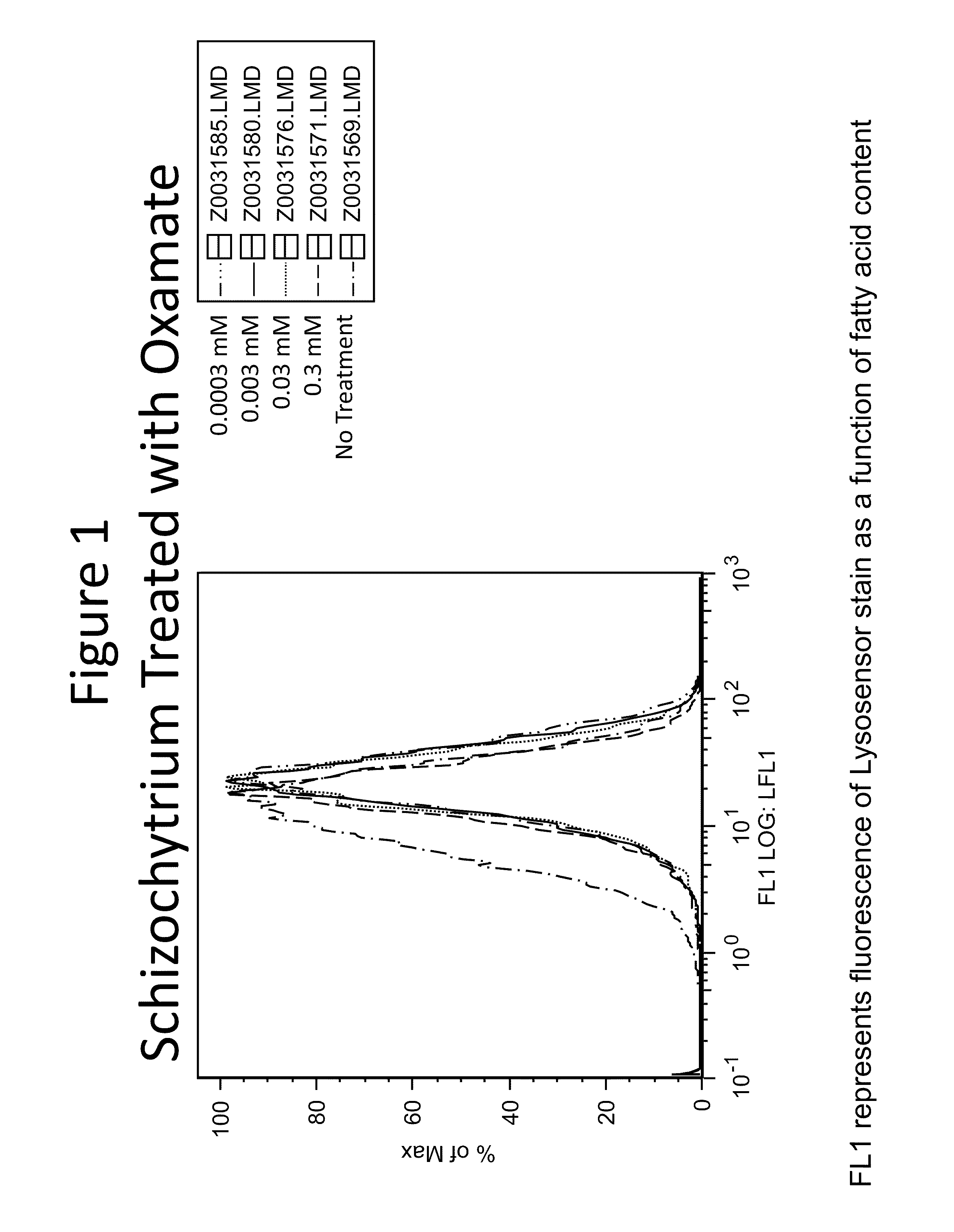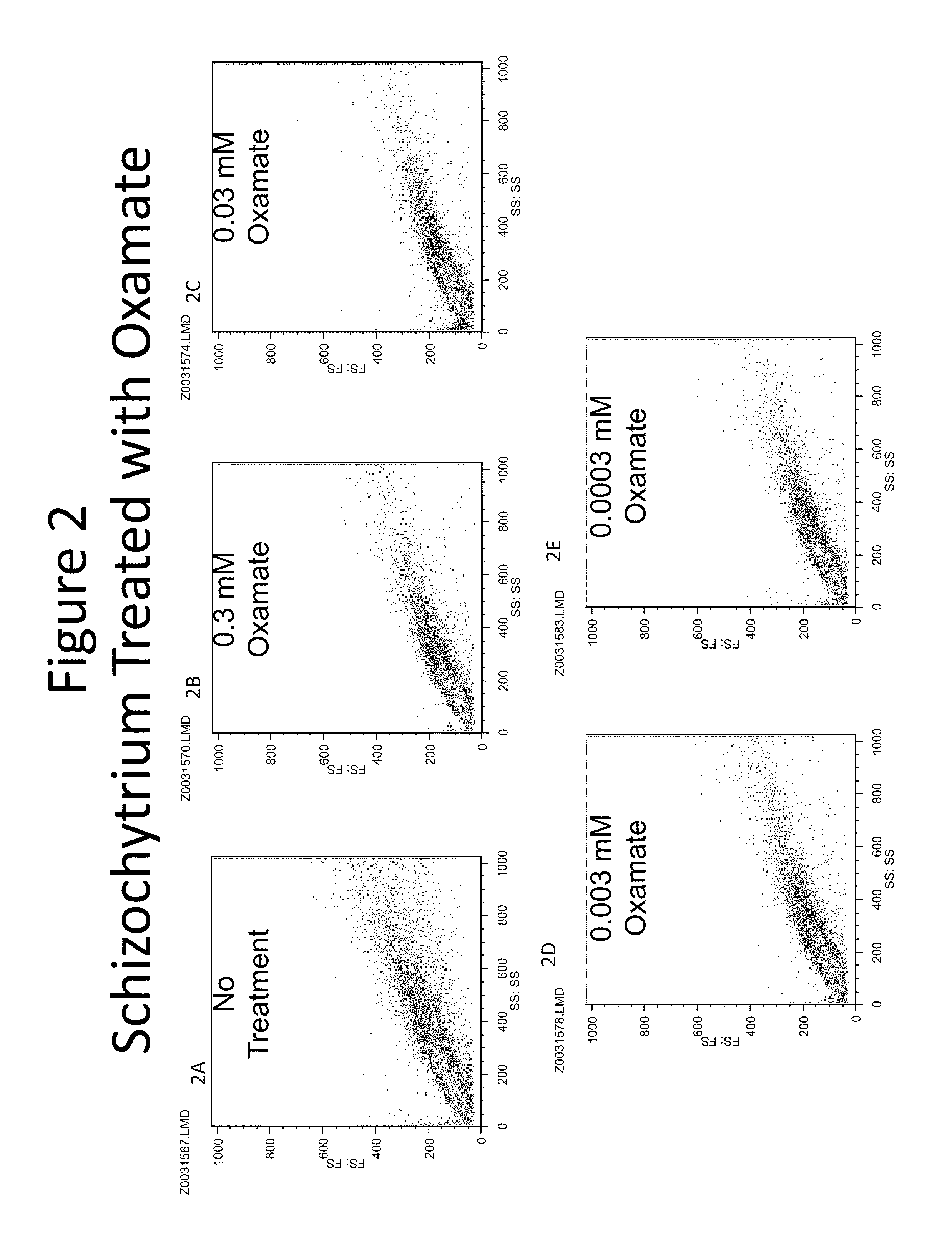Compositions and methods for promoting fatty acid production in plants
a technology of fatty acid production and composition, applied in the field of compositions and methods for regulating metabolism in plants, can solve the problems of algae-based biofuel growing in unfavorable traditional agriculture, fuel standard (rfs) poses a challenge, advanced refining reduces the possibility of gelling in lower temperatures, etc., to promote fatty acid oxidation and prevent, and potentially repair, free radical and oxidative damage to the organism
- Summary
- Abstract
- Description
- Claims
- Application Information
AI Technical Summary
Benefits of technology
Problems solved by technology
Method used
Image
Examples
example 1
Fatty Acid Accumulation in Schizochytrium
[0194]It was discovered that Schizochytrium, an algae like fungus accumulates or stores more fatty acids when treated with a fatty acid metabolism inhibitor, Oxamate, than untreated Schizochytrium. The results are shown in FIG. 1. The histograms depict quantities of Lysosensor as a measurement of fatty acid content in oil bodies, glyoxosomes, or lipid laden-organelles. Fl1 is fluorescence resulting from Lysosensor dye. Interestingly, the lowest concentration of oxamate was the most effective at producing high levels of fatty acid accumulation.
[0195]Dot plots of forward (fsc indicates size) versus side scatter (ssc, a measure of granularity) for each of the treatment groups of FIG. 1 were examined. Following treatment with oxamate (FIGS. 2B-2E) or untreated (FIG. 2A) cells were examined by flow cytometry in the same experiment as FIG. 1.
[0196]In order to determine why the lowest dose of oxamate was the most effective in producing high fatty a...
example 2
Fatty Acid Accumulation in Chlamydomonas reinhardtii
[0199]Increased fatty acid accumulation was also observed in the algae Chlamydomonas. FIG. 6 is a set of histograms depicting mitochondrial membrane potential as measured by Mitotracker Red dye (left panel) or UCP-2 (right panel). The cells are wild type or mutant Chlamydomonas lines as indicated. Uncoupling proteins as detected by fluorochrome-conjugated anti-Uncoupling antibody as expressed on mutant and wild type lines of Chlamydomonas are shown in the right panel.
example 3
Nutrient Accumulation in Corn, Oat Cucumber and Pea
[0200]Seeds of corn, oat, cucumber and pea were treated with inhibitors of fatty acid oxidation and examined for accumulation of fatty acids as evidenced by lack of germination. FIG. 7 is a photograph of corn seeds either treated with oxamate (B) or etomoxir (C) or untreated (A). FIG. 8 is a photograph of oat seeds either treated with oxamate (B) or etomoxir (C) or untreated (A). FIG. 9 is a photograph of cucumber seeds either treated with oxamate (B) or etomoxir (C) or untreated (A). FIG. 10 is a photograph of pea seeds either treated with oxamate (B) or etomoxir (C) or untreated (A).
[0201]Prior Studies
[0202]Prior studies performed by some of the inventors relating to the manipulation of UCP in plants are described in U.S. Pat. No. 7,105,718 issued on Sep. 12, 2006. Those studies are set forth below as background information relating to the methods described herein. These are as follows.
PUM
| Property | Measurement | Unit |
|---|---|---|
| pH | aaaaa | aaaaa |
| pH | aaaaa | aaaaa |
| fatty acid metabolism | aaaaa | aaaaa |
Abstract
Description
Claims
Application Information
 Login to View More
Login to View More - R&D
- Intellectual Property
- Life Sciences
- Materials
- Tech Scout
- Unparalleled Data Quality
- Higher Quality Content
- 60% Fewer Hallucinations
Browse by: Latest US Patents, China's latest patents, Technical Efficacy Thesaurus, Application Domain, Technology Topic, Popular Technical Reports.
© 2025 PatSnap. All rights reserved.Legal|Privacy policy|Modern Slavery Act Transparency Statement|Sitemap|About US| Contact US: help@patsnap.com



